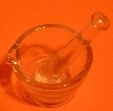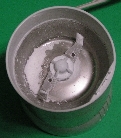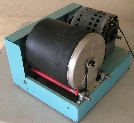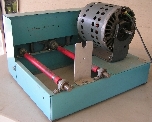|
Home ||
High Power Rocketry ||
Experimental Rocketry
There is quite a number of propellants used in experimental rocketry and
often people will get attached to one type or another and become quite
knowledgeable about that propellant. The three most common types of
propellants are compressed powder, usually black powder, sugar propellant
(most commonly sucrose, dextrose and most recently, sorbitol) and composite
propellant using ammonium nitrate or ammonium perchlorate as the
oxidizer and a powdered metal (usually aluminum or magnesium) as the fuel).
There are three well known people who are "experts" in each of these
propellants: David Sleeter (Teleflite
Corporation) has a book on black
powder motors "Amateur Rocket Motor Construction."
John Wickman has a book
"How to Make Amateur Rockets" and his propellant of choice is composite
propellant. Richard Nakka is the sugar rocket specialist and has the
most comprehensive experimental rocketry website bar none.
Note: You will see the term "grain"
used throughout this website. In black powders and smokeless powders,
the grain size refers to the size of each particle of powder which is quite
small, on the order of 1/16". In rocketry, the propellant is
compressed or cast into large forms just smaller than the motor diameter.
A motor may use one to as high as seven or more grains in a motor or the
propellant may be cast directly into the motor (case bonded grains) in which
case the entire mass of propellant is referred to as the grain.
Compressed propellant is prepared dry but may be wet at some stage of the
preparation. It is loaded into the motor casing by compressing with
constant mechanical or hydraulic pressure or by impact such as by blows of a
mallet or hammer. The burn rate depends on how fine the components are
ground, how intimately it is mixed, and the density which is determined by
how much it is compressed. Compressed propellants are normally loaded
into wound paper tubing which has a lower burst strength than PVC or metal.
An amateur will normally use blows to compress the propellant and this means
the amount of compression can vary and so getting a consistent rocket motor
becomes difficult and can result in burst motors or motors with lower
thrust. This is why I switched to cast sugar propellant. It is
also easy to split the casing because the hammer blows can create tremendous
hydraulic pressure on the casing. The normal way to avoid this is to
use an external clamp around the entire outside of the case. A series
of hose clamps can be used but this takes a fair amount of time to put them
all on and take them all off. I used a wood clamp that you can see in
my free manual. David Sleeter uses a fabricated steel clamp but a lot
of people don't have the tools to do that.
Zinc-Sulfur
In the early days of experimental rocketry powdered zinc and sulfur were a
common propellant. This was also referred as "micrograin." The optimum mixture was 2.04 parts zinc to one part
sulfur by weight. Its burn rate depends on how small the particle size
is for each and how much it is compressed. The more dense it is
compacted, the slower the burn rate. It's burn rate is between 14 and
290 inches per second. At 160 lbs/ft3 and 1000 psi, the
following has been measured*:
Burn rate - 90 in./sec
Flame Temp - 2600 F
Effective Exhaust Velocity - 1490 ft/sec
Specific Heat Ratio - 1.25
Molecular Weight - 97.45 lbs / mole
Specific Impulse - 45 sec
* from "How to Make Amateur Rockets", John H. Wickman, 2nd Ed, pg 3-3
Because it is so difficult to compress the powder to a known value
consistently, rocket motors made with this formula typically either don't
have much power and may not get off the launch pad, or they blow up from
over pressurization. It is not used by any serious rocketeers today.
Black Powder
Black powder is made from Potassium Nitrate (KNO3), Charcoal and Sulfur. The
common ratio is 75:15:10. Like zinc-sulfur, the burn rate depends on
the particle size and how much it is compressed. Black powder can be
used used as a propellant with more consistency than zinc-sulfur and is the
propellant used in small commercial model rocket engines.
My 1979
manual explains how to make and use black powder for rocket engines.
David Sleeter took the development to the next level and published his book,
Amateur Rocket Motor Construction. The burn rate of black powder can
be slowed by the addition of other components. I used calcium
carbonate. David uses baking soda. David also varies the type of
charcoal used to get different burn rates and to control chuffing. He adds
Red gum as a binder (I used Gum Acacia) and either water, alcohol, or
acetone is added before loading so the powder will compress more. I
did the same but also loaded it dry with good results.
Black powder, regardless of how fine it is ground, in the initial dry mix
state is not very powerful. It must be mixed with a little water until
it is a darker color and then dried again. While it is wet, it can be
pushed through a window screen to form grains. This grain powder is
extremely fast burning. Or it can be again ground up to a powder and
then it is still very fast burning. It is likely that the wetting
dissolves the KNO3 and then coats it around the charcoal and
sulfur particles so that it is in much more intimate contact with them.
Richard Nakka notes that sulfur is only used in conventional black powder so
it will ignite more easily from a spark such as is used in flintlock guns.
He makes black powder from 80% potassium nitrate and 20% charcoal by weight
for one of his igniters and presumably, this would also apply for black
powder motors but I have not tried this yet.
Sugar-KNO3
Sugar and potassium nitrate are the ingredients for the common "caramel
candy" propellant. Normally it is heated to a thick slurry but it also
can be just mixed together dry and then compressed in a motor tube in the
same way as black powder. As with all compressed propellants, the
particle size of the constituents and the degree of compaction is what
determines the burn rate and efficiency of the propellant and so it is
difficult to get a consistent product. Mixed in this way, it also is not as
powerful as when it is mixed more intimately through melting or dissolving
in water and then heating. The ratio is the same as for the melted
variety: 65% potassium nitrate, 35% sugar. See the
Carmel Candy Propellant
page for
more information on the melted method of preparing this propellant.
There is some variation in the definition of composite propellant.
It generally is considered to be a propellant where the oxidizer and the
fuel (reducing agent) are intimately mixed together with a binder.
Some define the composite propellant as being a rubber-like consistency and
then the binder is that which gives that property. However, asphalt
was an early binder and the finished product was not very elastic. Many
also consider epoxy propellants to be classed as a composite and although it
is tough rather than brittle, it definitely is not elastic. The other
problem with the definition is that the binder is also a fuel. It can
serve as the only fuel in the propellant, the main fuel with smaller amounts
of other fuel, or another substance may be the main fuel with the binder
being a lesser contributor. During the developmental years, some
propellants such as those using synthetic rubbers were cast at elevated
temperatures where they were liquid and then became solid when they cooled.
Others, essentially all propellants for amateur rockets and many for
commercial rockets, now are liquid at room temperature and a curing agent is
added which reacts chemically with the binder to cause it to harden over a
period of time, usually minutes to a few hours. Other substances that can be added are plasticizers and burn rate modifiers. A
plasticizer can be added to some to decrease the viscosity (make it thinner)
so that the propellant pours easier and makes the casting process easier.
Iron oxide can be added in small amounts to increase the burn rate and there
are other chemicals that could be added to slow it down (not common).
There are several types of iron oxide, different chemical formulas, with
varying amounts of iron and oxygen. For example, ferric oxide (Fe2O3)
is red, ferrous oxide (FeO) is black, and ferrous ferric oxide (Fe3O4)
is green.
This type of propellant solves one of the biggest problems of other
propellant types and that is brittleness. Any propellant that is
brittle can crack and that invariable causes over pressurization of the
motor due to increased burn area and catastrophic failure. Cracks can
occur not only from rough handling but also from the high pressure, thermal
stress, and g-forces experienced in flight. The bigger the grain size,
the more potential for cracks.
Virtually all motors for amateur use and most composite propellants for
commercial or military rockets use Ammonium Perchlorate as the oxidizer.
The oxidizer comprises 50% to 80% of the total by weight. The fuel is
usually a powdered metal, either Aluminum or Magnesium. The particle
size of the oxidizer and the powdered metal will make a difference in the
burn rate, the smaller the size, the faster the burn rate. These
propellants are harder to ignite than black powder or sugar based
propellants and require a longer burning, more intense igniter.
John Wickman is his great book
How to Make Amateur Rockets gives
these two formulas for composite propellant:
|
Ammonium perchlorate
Aluminum
R45M Binder |
68%
18%
14% |
Ammonium nitrate
Magnesium
R20LM Binder |
60%
20%
20% |
Grinding
Grinding is done to reduce the chemicals to a very small particle size.
This is required for any compressed powder motors and for dry melting
(melting the mixture without water.) You can grind the chemicals separately or you can grind them together IN
CERTAIN SITUATIONS. If grinding together, there must be no metal
involved in the operation so there can be no sparks and the heat generated
must be very low. Otherwise, you could ignite the powder. All
propellants that are mixed together dry are very flammable.
A ball mill with non-metallic "balls" is the only acceptable method and even
then, precautions must be taken in case of ignition. The dust inside
can be explosive.
Mortar and Pestle
 A small
amount can be done with a mortar and pestle but a person usually is looking
for an alternative pretty quickly. It can still be a good way when
experimenting with different formulas because it can be washed out quickly
and easily in preparation for the next chemical. This is also a good
method for preparing mixtures for igniters which don't use much for each
one. A small
amount can be done with a mortar and pestle but a person usually is looking
for an alternative pretty quickly. It can still be a good way when
experimenting with different formulas because it can be washed out quickly
and easily in preparation for the next chemical. This is also a good
method for preparing mixtures for igniters which don't use much for each
one.
Blender
You will probably read on many web sites that a blender is not a good method
of grinding chemicals. One reason is that it is harder to clean and
you have to make sure that there is no residue from a previous different
chemical before grinding the next. Also, a blender doesn't work that
well with solids. Nevertheless, it is a possibility and can be used.
Sometimes you have to keep pushing the chemical into the blades because it
tends to stack up and stick to the sides of the container. Be aware
that you can quickly dull the blades so don't use the kitchen blender.
Get one from a thrift store and dedicate it to your own project. reason is that it is harder to clean and
you have to make sure that there is no residue from a previous different
chemical before grinding the next. Also, a blender doesn't work that
well with solids. Nevertheless, it is a possibility and can be used.
Sometimes you have to keep pushing the chemical into the blades because it
tends to stack up and stick to the sides of the container. Be aware
that you can quickly dull the blades so don't use the kitchen blender.
Get one from a thrift store and dedicate it to your own project.
When I first started experimenting with black powder motors thirty years
ago, I used potassium nitrate and sulfur from the drugstore. I ground
up charcoal briquettes for the charcoal. There are binders in charcoal
that make it a poor source and that is probably why I found that a formula
of 68% KNO3, 20% charcoal, and 12% sulfur worked best for my chemicals
rather than the normal 75%, 15% 10%. I needed more charcoal to make it
work because of the impurities. I broke up the briquettes inside the
leg of an old pair of jeans with a hammer first, then poured some of that
into a blender and ground it up more. Finally, I sifted that through
some silk that I had used for model airplanes that had a very tight weave
(better than through nylons). It was a difficult, messy and time consuming
process but it resulted in a powder as fine as purchased air floated
charcoal. I recommend not wasting your time this way and just buying
your chemicals.
Coffee Mill
 A coffee mill does a job similar to a blender but it works a little better.
You can grind a little at a time but it does a better job of keeping the
material pulled into the blades. It was designed to grind solids so it
is a better choice. A new coffee mill (a cheap one) can be purchased
for about $15. It has the same problem of cleaning but with its low
price, a person could have more than one if he needed to grind more than one
ingredient. It is also a little faster, even though you can only grind
a little at a time, you can do it quickly and get a sizeable amount of
ground chemicals in a reasonable time through multiple batches. Check
for lumps that haven't been reduced to powder in both a blender and a coffee
mill before using. You might want to put it through a fine screen to
insure you don't have lumps. A coffee mill does a job similar to a blender but it works a little better.
You can grind a little at a time but it does a better job of keeping the
material pulled into the blades. It was designed to grind solids so it
is a better choice. A new coffee mill (a cheap one) can be purchased
for about $15. It has the same problem of cleaning but with its low
price, a person could have more than one if he needed to grind more than one
ingredient. It is also a little faster, even though you can only grind
a little at a time, you can do it quickly and get a sizeable amount of
ground chemicals in a reasonable time through multiple batches. Check
for lumps that haven't been reduced to powder in both a blender and a coffee
mill before using. You might want to put it through a fine screen to
insure you don't have lumps.
Ball Mill
The ball mill is the best way to grind and you can also grind all the
ingredients for black powder together. A ball mill is really a rock
tumbler. The rock tumbler is usually made of hard rubber at least on
the inside. Mine has an aluminum plate inside the rubber lid to help
give it rigidity but when it is closed up, there is no exposed metal.
When polishing rocks, the tumbler is filled about three quarter full of
rocks, then water and the abrasive is added to that. When grinding
chemicals or powder, a similar process is used except there is no water
added. David Sleeter in his book prescribed brass bar stock. I
checked into that and when I saw the price, I decided there IS another way.
I tried some rocks (after all, it really is a ROCK tumbler). I
used those for milling potassium nitrate. That worked fine so I also
used the rocks to mill charcoal (after washing them). That also worked
fine. I still had a little concern about using the rocks to grind
black powder with all the ingredients (explosive) because some rocks can
still produce sparks, though unlikely. Since I had already rejected brass bar stock,
I thought about glass marbles. They are cheap, round, totally spark
free. They worked GREAT creating dust consistency for everything I
tried in it--charcoal,
potassium nitrate and black powder.
|

This is my ball mill. It is a 1
gallon rock tumbler I got in Seattle from a lapidary supplier about 30
years ago. The motor is out of a washing machine. |
 There
is one driven rubber roller attached to the large pulley. There is
a small pulley on the motor. It is a double reduction system.
The drum actually turns at about 2 rpm. The drum has a grooved
plastic nut. The groove runs in the slot at the top of the white
angle bracket to keep it from moving along the roller axis and off the
machine. There
is one driven rubber roller attached to the large pulley. There is
a small pulley on the motor. It is a double reduction system.
The drum actually turns at about 2 rpm. The drum has a grooved
plastic nut. The groove runs in the slot at the top of the white
angle bracket to keep it from moving along the roller axis and off the
machine. |
 The
drum is all rubber and as can be seen has multiple flat sides.
This helps the contents to tumble rather than roll. The white
residue is KNO3 residue left from my last milled batch which
was milled to a talc like powder using 400 standard size glass marbles
that I got at a Dollar Store for 100 for $1.00. This has a
capacity of 1-1/4 gallons and will mill about two pounds in a batch.
Starting with lumps about half the size of the marbles and smaller, it
takes about six or eight hours to mill to dust. The
drum is all rubber and as can be seen has multiple flat sides.
This helps the contents to tumble rather than roll. The white
residue is KNO3 residue left from my last milled batch which
was milled to a talc like powder using 400 standard size glass marbles
that I got at a Dollar Store for 100 for $1.00. This has a
capacity of 1-1/4 gallons and will mill about two pounds in a batch.
Starting with lumps about half the size of the marbles and smaller, it
takes about six or eight hours to mill to dust. |
|
 The lid is composed of four parts as can be seen in the left picture:
the inner lid, the outer lid, a washer and plastic grooved nut.
The inner lid is rubber with an aluminum disk molded into it for
stiffness. The The lid is composed of four parts as can be seen in the left picture:
the inner lid, the outer lid, a washer and plastic grooved nut.
The inner lid is rubber with an aluminum disk molded into it for
stiffness. The bottom or rubber side of the inner lid can be seen in the picture on the
right. The inner lid fits snuggly inside the drum and provides an
entirely rubber milling area and also is water tight. (Rock
tumbling is done with water, an abrasive and the rocks). When the
outer lid is placed on, it helps snug the drum up against the inner lid.
bottom or rubber side of the inner lid can be seen in the picture on the
right. The inner lid fits snuggly inside the drum and provides an
entirely rubber milling area and also is water tight. (Rock
tumbling is done with water, an abrasive and the rocks). When the
outer lid is placed on, it helps snug the drum up against the inner lid. |
Black Powder
This method is mainly used for black powder. Whatever components are
not already in a fine powder need to first be ground. Usually the
sulfur is already a powder, at least if you have "flours of sulfur" or
"sulfur flour" or something similar. If you are making your own
charcoal from chunks, then it will need to be broken up into small pieces
first and then milled to a fine powder. "Air floated" charcoal can be
purchased and that doesn't need to be milled at all. Finally, the
potassium nitrate is probably not a fine powder and will probably need to be
milled. The individual components are usually first milled separately.
The mill needs to be thoroughly washed between uses of different chemicals.
Then the right proportions of each are milled together. Last, the
powder is mixed with just enough water (alcohol or acetone can be used
because they dry faster) to moisten the whole batch and if it is to be used
in a rocket motor, it can then be loaded directly and rammed in place by
blows with a mallet on a rod in the paper rocket tube. It can also be
let dry first and then re-ground and loaded dry. See the
1979 manual for details (pay attention to
it's revision)
Sugar and
Potassium Nitrate
As mentioned above, the same formula for melted caramel candy propellant can
be milled separately then mixed together and loaded dry into a paper motor
tube in the same way as black powder. It is difficult to get these to
be consistent and they don't have as much total power (specific impulse) as
using the heated method.
Zinc-Sulfur
This is the third type of compressed propellant but is not considered a
dependable fuel now since there is so much information and chemicals
available for other fuels. The method would be the same as for Sugar
and KN. The Zinc would have to be purchased already in a powdered
state since it can't be milled. It would then be dry mixed and
compressed with hammer blows on a dowel.
These methods are used exclusively for caramel candy propellants so are
detailed on that page.
This method takes in all other propellant types that have at least one
non-liquid component and includes especially composite propellant and Epoxy
propellant. These are just mixed together thoroughly and then a
hardener is added which will cause the liquid slurry to harden over a short
period of time, usually half an hour to several hours.
Home ||
High Power Rocketry ||
Experimental Rocketry
|
